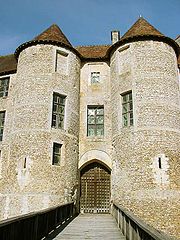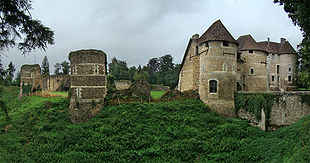
Château d'Harcourt
Encyclopedia
The Château d'Harcourt, situated in the commune of Harcourt
in the Eure
département of France
, is a masterpiece of medieval architecture. The cradle of the Harcourt family, the castle is one of the best preserved castles in the country and contains the oldest arboretum
in France.

 Although the lords of Harcourt trace their origins to the year 1000, it is only in the second half of the 12th century that the existence of a castle can be proven from historical texts. Robert II d'Harcourt was a companion in the crusade of Richard Lionheart; the first stone castle was certainly built by him. Harcourts appear later among the most important barons of Normandy
Although the lords of Harcourt trace their origins to the year 1000, it is only in the second half of the 12th century that the existence of a castle can be proven from historical texts. Robert II d'Harcourt was a companion in the crusade of Richard Lionheart; the first stone castle was certainly built by him. Harcourts appear later among the most important barons of Normandy
. Jean II d'Harcourt, for example, was named Marshal of France and accommodated in his residence king Philip III
. In 1338, king Philip VI
, set up the seigniory of Harcourt, with the Château d'Harcourt forming its principal town.
The fortress appears to have seldom been under siege through history. It is only at the time of the Hundred Years' War
that Harcourt became a military base. In 1418, the castle was claimed by the English, but they were eventually expelled by the counts of Dunois
, Eu and Saint-Pol in 1449. As the war came to a close, the domain returned to the Rieux family, then, starting from the second half of the 16th century, to the powerful Lorraine-Guise family
. The French Wars of Religion
caused an increase in defensive fortifications in the castle. In 1588, the members of a league occupied the castle. In the 17th century, the castle lost all military interest; it was then partially abandoned and invaded by vegetation after Louis Gervais Delamarre acquired it in 1802. With his death, Harcourt was bestowed to the Royal Academy of Agriculture of France . Today, the council general of Eure is the owner.
 It is thought that the Château d'Harcourt consisted in the beginning of a motte-and-bailey
It is thought that the Château d'Harcourt consisted in the beginning of a motte-and-bailey
surrounded by a ditch, like many of the other fortresses of the time. In the 12th century, a square stone tower took the place of earlier wooden constructions. The castillar architecture then evolved according to the progression of siege
s, and the rise of its successive owners. In the 13th century the old keep
was integrated in a polygonal castle. The bailey
was protected by a curtain wall punctuated by nine round towers. Ahead of the curtain wall, a deep ditch, dry most of the time (lacking a river to feed it), girdled the structure.
Through the 14th century, the defence of the castle continued to improve. A monumental fortified door, a châtelet
, was installed to defend the more exposed of the two entries. The archeries were enlarged to allow firing crossbow
s.
In the 17th century, Marie Françoise de Brancas (d.1715), wife of Alphonse Henri, Count of Harcourt
, undertook to refit the medieval fortress to make it more hospitable. A friend of Madame de Maintenon, she demolished three sides of the polygonal castle and thus opened her apartments to the light. With a similar aim, large rectangular bays were bored and the interior disposition was re-examined.
The medieval Château d'Harcourt appears truncated today, especially as the top of the keep was levelled to bring it to the same height as the other buildings. There is no longer any building in the bailey, though a chapel was probably there formerly.
The castle is listed as a monument historique
by the French Ministry of Culture.
Harcourt, Eure
Harcourt is a commune in the Eure department in the Haute-Normandie region in northern France.-Population:-Sights:*Château d'Harcourt - a medieval-built château with the oldest arboretum in France.*Arboretum d'Harcourt-External links:*...
in the Eure
Eure
Eure is a department in the north of France named after the river Eure.- History :Eure is one of the original 83 departments created during the French Revolution on 4 March 1790...
département of France
France
The French Republic , The French Republic , The French Republic , (commonly known as France , is a unitary semi-presidential republic in Western Europe with several overseas territories and islands located on other continents and in the Indian, Pacific, and Atlantic oceans. Metropolitan France...
, is a masterpiece of medieval architecture. The cradle of the Harcourt family, the castle is one of the best preserved castles in the country and contains the oldest arboretum
Arboretum
An arboretum in a narrow sense is a collection of trees only. Related collections include a fruticetum , and a viticetum, a collection of vines. More commonly, today, an arboretum is a botanical garden containing living collections of woody plants intended at least partly for scientific study...
in France.

History

Normandy
Normandy is a geographical region corresponding to the former Duchy of Normandy. It is in France.The continental territory covers 30,627 km² and forms the preponderant part of Normandy and roughly 5% of the territory of France. It is divided for administrative purposes into two régions:...
. Jean II d'Harcourt, for example, was named Marshal of France and accommodated in his residence king Philip III
Philip III of France
Philip III , called the Bold , was the King of France, succeeding his father, Louis IX, and reigning from 1270 to 1285. He was a member of the House of Capet.-Biography:...
. In 1338, king Philip VI
Philip VI of France
Philip VI , known as the Fortunate and of Valois, was the King of France from 1328 to his death. He was also Count of Anjou, Maine, and Valois from 1325 to 1328...
, set up the seigniory of Harcourt, with the Château d'Harcourt forming its principal town.
The fortress appears to have seldom been under siege through history. It is only at the time of the Hundred Years' War
Hundred Years' War
The Hundred Years' War was a series of separate wars waged from 1337 to 1453 by the House of Valois and the House of Plantagenet, also known as the House of Anjou, for the French throne, which had become vacant upon the extinction of the senior Capetian line of French kings...
that Harcourt became a military base. In 1418, the castle was claimed by the English, but they were eventually expelled by the counts of Dunois
Jean de Dunois
John of Orléans, Count of Dunois was the illegitimate son of Louis d'Orléans by Mariette d'Enghien.The term "Bastard of Orléans" John of Orléans, Count of Dunois (French born "Jean Levieux Valois des Orléans" better known as Jean d'Orléans, comte de Dunois, also known as John of Orléans and...
, Eu and Saint-Pol in 1449. As the war came to a close, the domain returned to the Rieux family, then, starting from the second half of the 16th century, to the powerful Lorraine-Guise family
House of Guise
The House of Guise was a French ducal family, partly responsible for the French Wars of Religion.The Guises were Catholic, and Henry Guise wanted to end growing Calvinist influence...
. The French Wars of Religion
French Wars of Religion
The French Wars of Religion is the name given to a period of civil infighting and military operations, primarily fought between French Catholics and Protestants . The conflict involved the factional disputes between the aristocratic houses of France, such as the House of Bourbon and House of Guise...
caused an increase in defensive fortifications in the castle. In 1588, the members of a league occupied the castle. In the 17th century, the castle lost all military interest; it was then partially abandoned and invaded by vegetation after Louis Gervais Delamarre acquired it in 1802. With his death, Harcourt was bestowed to the Royal Academy of Agriculture of France . Today, the council general of Eure is the owner.
Architecture

Motte-and-bailey
A motte-and-bailey is a form of castle, with a wooden or stone keep situated on a raised earthwork called a motte, accompanied by an enclosed courtyard, or bailey, surrounded by a protective ditch and palisade...
surrounded by a ditch, like many of the other fortresses of the time. In the 12th century, a square stone tower took the place of earlier wooden constructions. The castillar architecture then evolved according to the progression of siege
Siege
A siege is a military blockade of a city or fortress with the intent of conquering by attrition or assault. The term derives from sedere, Latin for "to sit". Generally speaking, siege warfare is a form of constant, low intensity conflict characterized by one party holding a strong, static...
s, and the rise of its successive owners. In the 13th century the old keep
Keep
A keep is a type of fortified tower built within castles during the Middle Ages by European nobility. Scholars have debated the scope of the word keep, but usually consider it to refer to large towers in castles that were fortified residences, used as a refuge of last resort should the rest of the...
was integrated in a polygonal castle. The bailey
Ward (fortification)
In fortifications, a bailey or ward refers to a courtyard enclosed by a curtain wall. In particular, an early type of European castle was known as a Motte-and-bailey. Castles can have more than one ward. Their layout depends both on the local topography and the level of fortification technology...
was protected by a curtain wall punctuated by nine round towers. Ahead of the curtain wall, a deep ditch, dry most of the time (lacking a river to feed it), girdled the structure.
Through the 14th century, the defence of the castle continued to improve. A monumental fortified door, a châtelet
Castle
A castle is a type of fortified structure built in Europe and the Middle East during the Middle Ages by European nobility. Scholars debate the scope of the word castle, but usually consider it to be the private fortified residence of a lord or noble...
, was installed to defend the more exposed of the two entries. The archeries were enlarged to allow firing crossbow
Crossbow
A crossbow is a weapon consisting of a bow mounted on a stock that shoots projectiles, often called bolts or quarrels. The medieval crossbow was called by many names, most of which derived from the word ballista, a torsion engine resembling a crossbow in appearance.Historically, crossbows played a...
s.
In the 17th century, Marie Françoise de Brancas (d.1715), wife of Alphonse Henri, Count of Harcourt
Alphonse Henri, Count of Harcourt
Alphonse Henri de Lorraine was a member of the House of Lorraine and Count of Harcourt.-Biography:...
, undertook to refit the medieval fortress to make it more hospitable. A friend of Madame de Maintenon, she demolished three sides of the polygonal castle and thus opened her apartments to the light. With a similar aim, large rectangular bays were bored and the interior disposition was re-examined.
The medieval Château d'Harcourt appears truncated today, especially as the top of the keep was levelled to bring it to the same height as the other buildings. There is no longer any building in the bailey, though a chapel was probably there formerly.
The castle is listed as a monument historique
Monument historique
A monument historique is a National Heritage Site of France. It also refers to a state procedure in France by which national heritage protection is extended to a building or a specific part of a building, a collection of buildings, or gardens, bridges, and other structures, because of their...
by the French Ministry of Culture.

